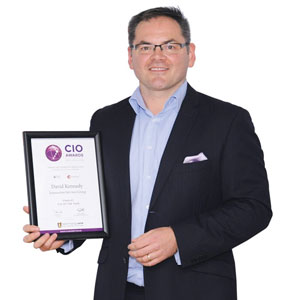THANK YOU FOR SUBSCRIBING

Liberty Mutual Insurance
Sourabh Chitrachar, The Regional Vice President- Asia Technology Strategy & Operations, Liberty Mutual Insurance


Sourabh Chitrachar, The Regional Vice President- Asia Technology Strategy & Operations, Liberty Mutual Insurance
Sourabh Chitrachar is the Regional Vice President of Asia Technology Strategy & Operations at Liberty Mutual Insurance. He looks into Regional IT Strategy formulation across seven countries and implementation closely aligned with the Market & Regional Executive Leadership. Sourabh is a business-focused IT management professional with solid hands-on exposure to IT strategy, management, delivery engineering & transformation. He has experience in IT service delivery, service design, and organizational change management, including offshoring and restructuring.
How has digital transformation benefited insurance, claims processing, or the whole industry?
There are 2 major interfaces for customers during the lifecycle of their relationship with an insurance carrier. These 2 are during the ‘buying’ or ‘claims’ process. In general, claims processes are manually intensive and are triggered the moment a customer notifies the insurance company about a claim due to loss they incurred. With claims, there are losses involved for an insurance company and there are numerous incidents of fraud which comprise almost $40B annually in US alone, which necessitate the carriers to handle claims with proper due diligence and scrutiny. General insurance companies have commercial and retail business, and as an industry, there are tight regulations due to potential loss of customer data.
If you look at claims process, it’s quite manually intensive and even more when it comes to Commercial Claims processing due to the nature of complexity of Claims. However, due to change in customer expectations and need to optimize the costs, digital transformation becomes a necessity, and the methods are shifting.
The retail or personal lines Claims space has transformed a lot with the advent of technologies like AI, ML and RPA, helping claims to be processed faster. The claims in segments like Motor insurance that took as long as a week to be processed can now are processed within five to ten minutes by means of video claims processing and AI (using image analysis of the damage and linkage to parts & labor databases) technologies and the insurance companies are looking at a straight through processing rate of ~ 90% without any intervention from Underwriters or Claims handlers. For the remaining, 10% which are more complex require manual intervention necessitating physical site surveys and manual processing. I am sure even this 10% will reduce in future as the technology and the AI algorithms are evolving. The net outcome is a faster processing time for customers enhancing their claims experience and potentially better retention rate for the insurance carrier. Additionally, it helps improve the efficiency of the internal processes and lower the costs for the insurers and the employees involved in these areas can be redeployed to perform more value- added tasks in the form of better risk modeling or fraud prevention rather than manual mundane tasks on a daily basis.
So that’s where this landscape or this area of insurance is progressing, especially in motor and travel claims.
But when you look at life or health, for example, it’s a slightly different ball game because life or health claims are different as its lot more complicated and you still need to go through assessments via the medical practitioners, claims handlers, etc. which takes a longer time. However, there are advancements even in that space which is helping in terms of reducing the duration or processing time for the claims.
Apart from Claims, the other areas where digital transformation is helping insurance carriers are
• improving distribution capabilities by automated premium quoting and policy issuance
• new business models like “Pay as you use/ go”, Peer to Peer insurance with embedded ecosystem models
• Better Risk modelling using advanced AI algorithms
• Insurance Pricing by utilizing internal and external databases to provide dynamic pricing capabilities in order to remain competitive and compliant
• Internal operational efficiencies by automating manually intensive processes within Claims, Underwriting, Operations, etc.
What are the challenges faced by insurance companies with the new technologies, and how are these helping in mitigating the challenges?
In the technology landscape, there is a huge adoption of multiple types of technologies, not just in the retail sector but also in the commercial and there are technologies like AI, ML, RPA, Advanced Analytics and block chain being used and are powered by advancements in underlying cloud based technologies. One of the challenges which is persistent is the lack of skills when it comes to adoption of these modern technologies. Traditional insurance companies might not have those skills unless they have a long- term forward looking technology strategy aligned to the business strategy. There should be a clearly defined talent strategy focused on the entire Employee Value Proposition across the employee lifecycle ensuring the right focus on attracting technology talent, retaining them and developing them to support the necessary required skills to support the long term business objective. The skills need not always be developed but could also be bought or borrowed from external providers but it’s important to understand what outcomes are you trying to achieve.
-
There will always be changes and challenges in execution but collaborating, understanding, and taking the right decision are important to achieve the to achieve the outcomes expected as a part of the broader vision
The second challenge is around legacy systems and traditional process which requires a thorough evaluation and clear action planning by means of regular assessments in progress. The way to mitigate this is by means of a clearly defined business transformation approach with a keen focus on innovation and modernization and requires a strong management support and commitment. A part of the budget needs to be set aside to modernize the existing systems as technologies evolve every 3-5 years and what is modern today, becomes a technology debt 3-5 years down the line. Its critical that IT leaders work hand in hand with the business leaders to understand their needs and concerns and also educate them in the process to achieve outcomes which create quantifiable business values. This is a continuous journey, so, will require ongoing management support and long term program management approach with course corrections along the way.
Is there any advice you would like to give your counterparts in the industry or anything you would like to share with the readers?
There is no silver bullet to success and the path is never smooth but with a clear vision and the right support, you can move towards progress. For a technology organization to function and act as an enabler to business outcomes, you need to work collaboratively with the business leaders understand the problems and try to solve them. At the end of the day, you’re driving a business outcome that needs to be aligned in close collaboration with your stakeholders at all levels. Knowledge is critical to achieve the success as that helps boost confidence for business stakeholders and hence, it’s important for technology teams to gain business knowledge. Lastly, when you look at business outcome, technology is a key enabler for achieving that outcome. You should be able to navigate through those changes with a clear mind and a clear vision. It is not necessary that your previous or current strategies are going to be used in the future as well. What you have been used to doing might not take you further. You need to have a growth mindset to deliver meaningful outcomes.












